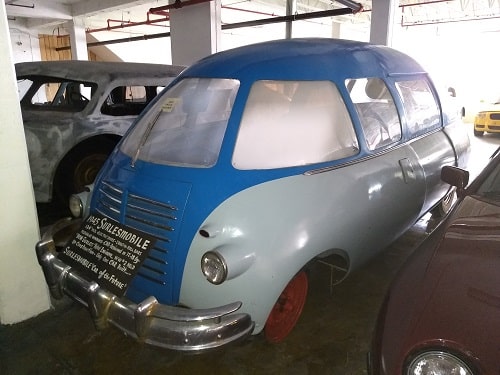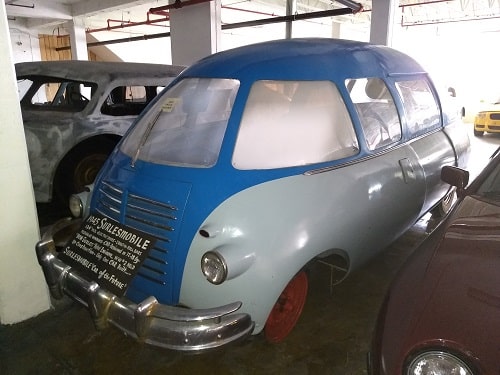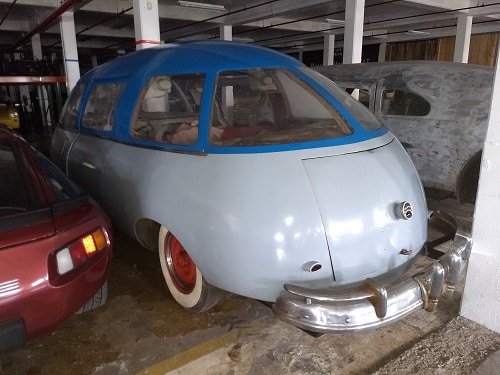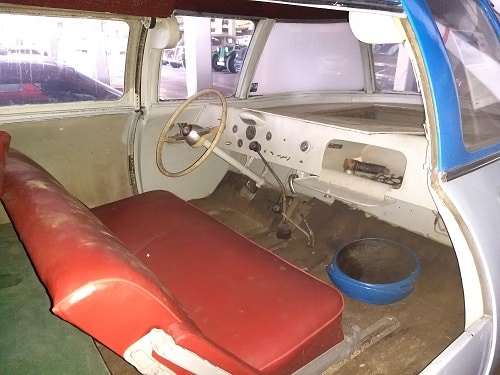
Surlesmobile- 1945

As a lieutenant in the Army Air Forces, Texas native Don Surles had an innovative idea. It stemmed from his thoughts on why someone hadn’t designed a more practical door. He imagined a door, “that would open without hitting the curb or another parked car. A door you could leave open as you backed out of the garage…one that wouldn’t be in your way when you climbed in and out of the car… and above all, a door and window that would never rattle.”
The ingenious design Surles came up with was a retractable two-piece, hide-away portal. The top half disappeared into the car’s roof and the lower half into the floor of the car, like a clamshell. He imagined the doors would operate electronically: “A touch of a button and the side of the car seems to slide away. When you cross the threshold you seem to enter a sumptuous room rather than a motor car.” But the heavy tracks that guided the sliding doors also formed twin roll bars, reinforcing the car’s mid-section and acting as a forward-thinking safety feature.
In the military, Surles was stationed in occupied Japan. Surrounded by inexpensive labor and skilled craftspeople to fabricate and build his unique design, this was the perfect opportunity for starting his project. According to a 1948 Popular Science article, Surles bought a surplus GPW Jeep for $335 and began his work. In recounting the process, he removed the body and cut the frame off just behind the transmission, “…40 inches were added to the driveshaft to make it half again as long as the original.” The rear axle was modified with jeep parts and resulted in a rear axle track almost 8 inches wider than the front. The streamlined, cigar-shaped body was designed by Surles, then fabricated and installed by Tokyo Bus Works for $400.
Surles hoped this would be a “new breed of American cars.” And he believed it was, “as close to perfection as the motor car has come in luxury, comfort, and performance.” His plan was for more. He had designed a better engine with more power, made specifically for the Surlesmobile; “…this engine has 16 power strokes per crank-shaft revolution, giving a smooth flow of power at any speed,” and he declared that “it may be the most perfectly-balanced engine ever designed.” But promoting his Surlesmobile was the difficult part. In a 1966 Washington Post article, Surles recounts that, upon returning and importing his Surlesmobile into the US, he took it around “to every manufacturer there was” with high hopes. But unfortunately he elicited no interest. Then he brought his dream car back to his home in Fairfax County, VA where it sat for a while. At the time of the article, Surles relented: “My wife doesn’t like the thing cluttering up the driveway.”
Don Surles let the patents expire for his car’s most innovative feature; the “slide-away” doors. Within 30 days, General Motors announced the “Glide-Away” tailgate on the 1971 Chevrolet station wagon. After that, the Pontiac Safari, Oldsmobile, and Buick Estate Wagons all featured Glide-Away-style tailgates, disappearing into the roof and the floor of the vehicle, providing unrestricted access to the cargo area.
In the 1948 Popular Science article Surles states; “…the Surlesmobile was built for the sole purpose to ascertain whether or not this door was practical…it has proved not only practical, but essential.”
Don Surles was right!
Specifications:
Manufacturer: Don Surles (design) Tokyo Bus Works (fabrication)
Country of Origin: USA (chassis) and Japan (body modifications)
Drivetrain Configuration: Front engine, four-wheel drive
Engine: Water-cooled, 2.2L (2199cc) “Go-Devil” 4 – 134 L-Head Engine 60hp
Transmission: 3-speed Manual
Top Speed: 70 mph
Years of Production: 1945
Number Produced: 1
Original Cost: $1,000


